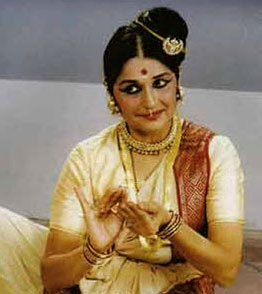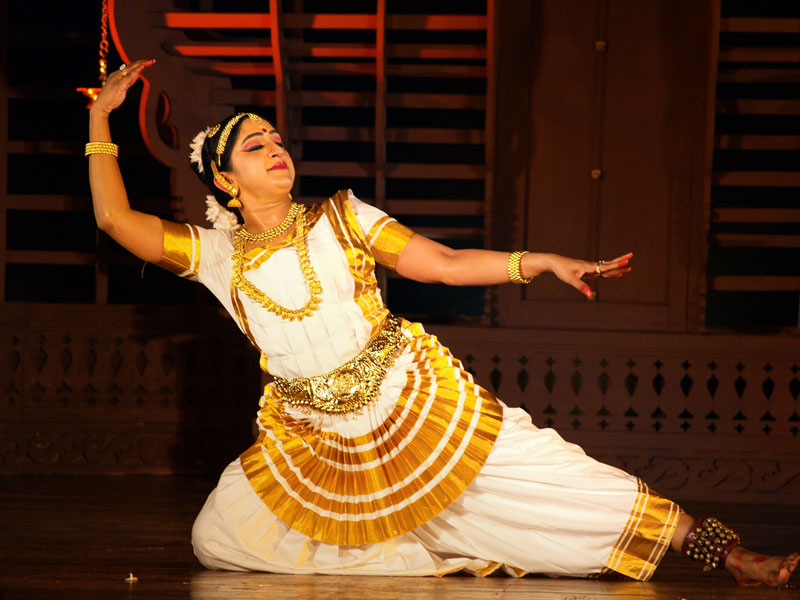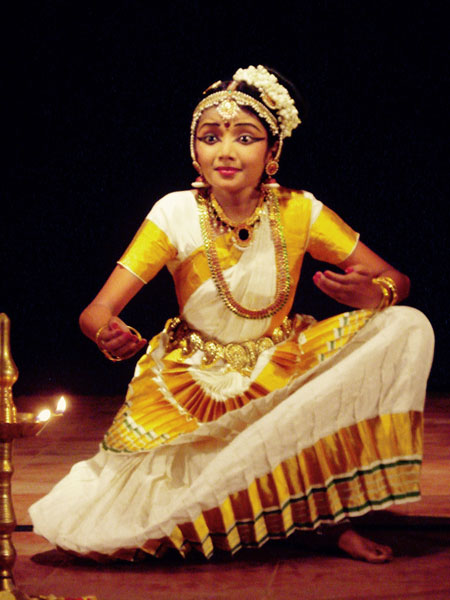Mohiniyattam — Captivating grace
The gentle swaying of luscious coconut trees in the breeze dancing to the rhythm of the undulating waves of the Arabian Sea lapping Kerala’s coastline is truly a wondrous sight to behold. These intrinsically graceful movements are reflected in the lilting movements of Mohiniyattam, a traditional dance performed by women in Kerala. The dance is based on Lasya or the feminine aspect of dance attributed to Goddess Parvati, the consort of Siva. The name is derived from Mohini, an avatar of Vishnu who appears as a divine beauty during a battle between the Devas (good) and the Asuras (evil). She uses her supreme charm to procure the Amrita, the nectar of immortality, and distributes it among the Devas thus ensuring that only good will prevail in the world.
Mohiniyattam was initially known as Thevaradiachi which means the daasi or servant at God’s feet and originally a temple dance performed exclusively by women. It was banned by the Dutch during their regime in Kerala and later revived by Maharaja Swati Tirunal Rama Varma who brought the court dancers to Kerala and composed many new padams to create a new repertoire. The anti-nautch movement by the British in 1892 created a further decline of classical dances all over India and stigmatised Mohiniyattam in the princely States of Cochin and Travancore. The supposedly seductive gestures of the temple dances were caricatured in The Wrongs of Indian Womanhood published in the beginning of the 20th century and a ban was imposed which was partially repealed in 1940. Mohiniyattam was revived and reconstructed by the nationalist poet Vallathol Narayana Menon who helped repeal the ban and initiated its preservation by establishing the Kerala Kalamandalam. This iconic institution has honed the dancing skills of many legendary Mohiniyattam artists who have taken this art to many parts of India and also foreign shores. Kalyanikutti Amma was one of the legendary Mohiniyattam alumni of Kerala Kalamandalam and was married to the Kathakali maestro Kalamandalam Krishnan Nair. She was instrumental in resurrecting the dance from a near-extinct state and including it in mainstream Indian classical dance by giving it a formal structure. Her book, Mohiniyattam – History and Dance Structure is regarded as an elaborate and authentic documentation of the dance form.
I’m against this ‘classical dance’ nomenclature. It is very British.
— Mohiniyattam exponent Kanak Rele
Mohiniyattam is traditionally an expressive solo dance or Ekaharya abhinaya performed in the Kaisiki Vritti (graceful style) that is prescribed in Bharatha’s Natya Shastra. The repertoire is similar to Bharatanatyam and the seven main items that are performed are Cholkattu (invocation to Goddess Bhagavati), Swarajati or pure dance, Varnam, where the dancer elaborates a story or theme, Padam, describing emotions, Tillana or pure dance, Shlokam and Saptham. The dance can be recognised by the basic posture of standing with feet wide apart and knees bent outwards and the gentle swaying movements of the body. The footwork is also soft with sliding movements and hand gestures that synchronise with the rhythm. The lyrics of many traditional songs are in Manipravalam which is a mixture of Sanskrit, Malayalam and Tamil. The costume is stunningly beautiful in its very simplicity. It is usually an off-white and gold dress made of cotton and ornaments of the region are worn as embellishments. The hair, tied in a knot on the left side, is decorated with jasmine flowers. The stone carvings of dancing girls adorned in similar attire found across many temples in South India establish a rock solid connection between dance and the temples.
Dr Kanak Rele was a Gujarati from a business family who started learning Mohiniyattam after her marriage at the age of 28. She was a Kathakali and Bharathanatyam dancer before she became a Mohiniyattam artiste. She had her initial training from Guru Rajalakshmi from Kerala Kalamandalam on the suggestion of her Kathakali guru ‘Panchali’ Karunakar Panicker and later delved deeper into the art under the tutelage of great gurus like Chinammu Amma, Kalyanikutti Amma and Kunjukutti Amma aided with a grant from the Sangeet Natak Akademi and a scholarship from the Ford Foundation. She is the founder-director of the Nalanda Nritya Kala Mahavidyalaya in Mumbai, which trains students for a Bachelor’s and Master’s degree in Mohiniyattam and is recognised as a research institute by the Ministry of Science and Technology. “My desire to keep the tradition of Indian classical dance alive made me establish Nalanda. I don’t want an art lover or learner to face such problems which I went through during my learning period. It used to be an oral tradition. People should know that apart from dancing on stage we have so much to study to know the subject well. Mythology, temple architecture and dance therapy are all important subjects that I have introduced in Nalanda” she said.
Kanak Rele has played a key role in the revival and popularisation of Mohinyiattam. She brought a scientific temper and academic rigour to it. Her concept of body kinetics in dance is a pioneering innovation that disaggregates body movements in Mohiniyattam using a notation system. “This idea of wanting to learn the science behind the body kinetics of dance came upon me when I got involved with specially-abled children. I began working with the children under experts in physiotherapy, orthopaedics, learnt anatomy and related it to dance. It was an eye-opener. I began to dissect each and every move of the limbs, muscles, nerve twitches, etc. and deduced my theory on body kinetics in dance.”
Bharati Shivaji, Founder of the Centre for Mohiniyattam, New Delhi, says that the dance did not have an identity earlier because, a little this way, it would lean towards Kathakali, a little that way, towards Bharatanatyam. Like in Nritta, for example, “I felt the technique of Mohiniyattam was very limited. When I attended a workshop with the Krishnattam group in Guruvayur, I found the Nritta is so beautiful. It is so lasya.”
Dancer Gopika Varma says,”Mohiniyattam is a highly evolved dance where the bhava (emotions) and abhinaya (expressions) play a pivotal role where there is no such thing as jathis (rhythmic footwork patterns). It requires an exclusive sense of involvement and exceptional tala pace as the dance is to be done in a calculated slow and steady motion and there is always this temptation to quicken. It calls for contained, conscious and restrained pace setting if the dancer is to maintain perfection in laya, tala and katha.” Since the dance has no external trimmings like elaborate costumes or gimmicks, “we have to bank entirely on our eye language, facial expression and hand gestures throughout the three-hour recital with sway and swinging movements/footwork.”
 Mohiniyattam has grown from solo to group presentations and the themes have also moved from regional to a global level. Another interesting development is breaking stereotypes by welcoming male dancers into its fold. The cascading dance movements, melodious music and alluring costume harmonise to create an ethereal effect. Little wonder that it is described as the dance of the enchantress.
Mohiniyattam has grown from solo to group presentations and the themes have also moved from regional to a global level. Another interesting development is breaking stereotypes by welcoming male dancers into its fold. The cascading dance movements, melodious music and alluring costume harmonise to create an ethereal effect. Little wonder that it is described as the dance of the enchantress.
Kanak Rele says, “I’m against this ‘classical dance’ nomenclature. It is very British. The word ‘Shastra’ envisages more than mere classicality; it also means science; the science of body movement which translates itself into an art through imbibing certain aesthetic characters aided by music and rhythm. This when taken to its highest level of conclusion culminates in a bliss which is akin to spiritual enhancement.”
Photo courtesy: wikicommons.org



